New benchmarking report shows companies how to maximize AI’s power and versatility to win more business, run projects more profitably, and meet compliance responsibilities more efficiently.
As much promise as government contracting companies see in artificial intelligence (AI) as a tool to bolster their business, they’re approaching it with caution, according to findings from a newly released benchmarking report for the GovCon industry.
The GAUGE Report (available for free download here) surveyed more than 1,200 contributors, the majority of whom are upper-level GovCon executives. About one-third of respondents indicated their companies are currently using AI. That number puts the GovCon industry well behind AI adoption rates in other industries. In a separate benchmarking report produced by Unanet for the architecture, engineering and construction industries, for example, more than half the companies we surveyed indicated they currently use AI.
While the government contracting sector’s guarded approach to AI makes sense in light of the various risks — regulatory, security, ethical, etc. — that companies must address when implementing it, there’s also significant risk in being too slow to explore how the technology can benefit a GovCon business. As the 2024 GAUGE Report posits, “From enhancing strategic forecasting and planning, automating tedious administrative tasks, detecting operational issues and analyzing data trends, AI offers many powerful capabilities that growth-minded GovCon businesses can no longer afford to ignore.”
The 2024 GAUGE Report offers a detailed look at how a GovCon company’s AI journey typically unfolds, from resistant (a stage companies would be wise to avoid altogether given the benefits AI can bring) to mature:
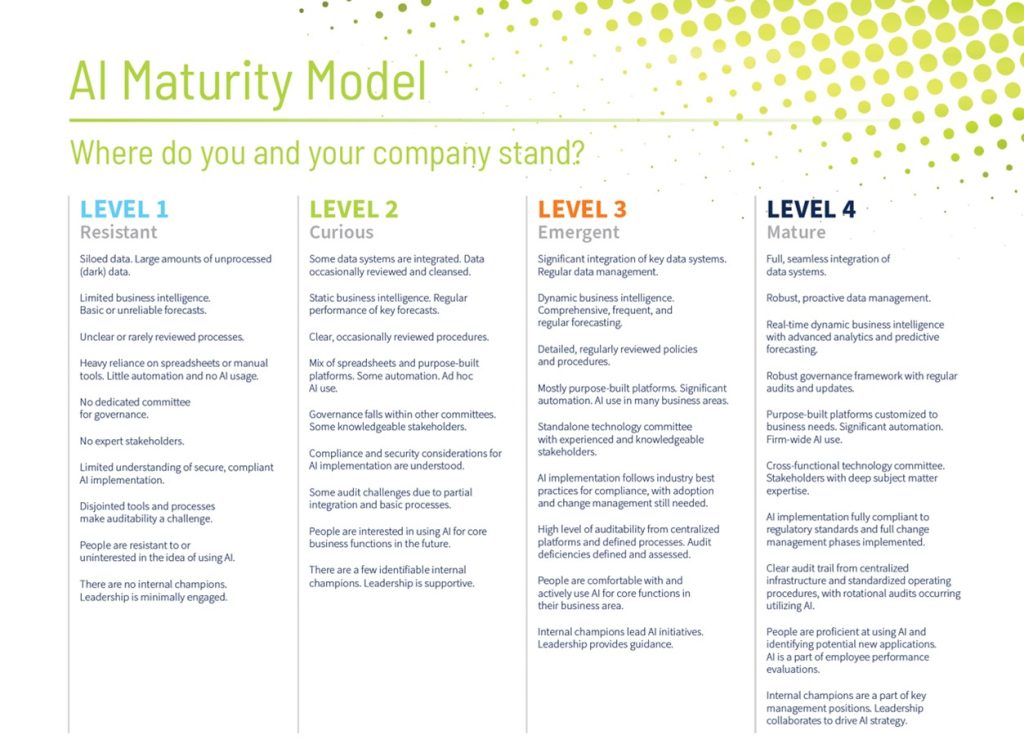
Where does your company land on the maturity spectrum currently? And what’s the rationale for pushing your company further along the spectrum?
The 2024 GAUGE Report found that GovCon companies are most interested in applying AI in two areas: business development/marketing and operations/IT. More than half of the GovCons surveyed said they either currently use or plan to use AI in these two areas in the next year. Content generation and data analysis are the two areas of their business where they see AI potentially providing the most value. Interestingly, GovCon execs identified finance and accounting as the area in which they have the least interest in applying AI in the next 12 months.
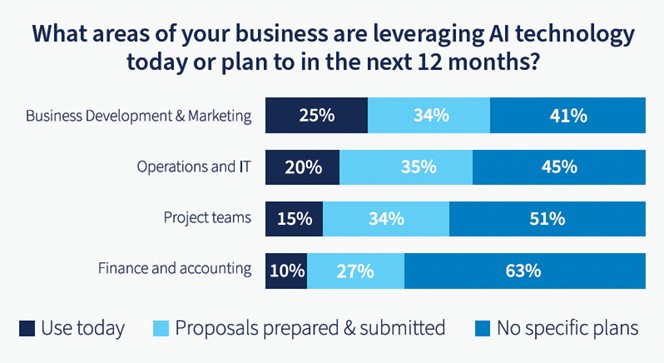
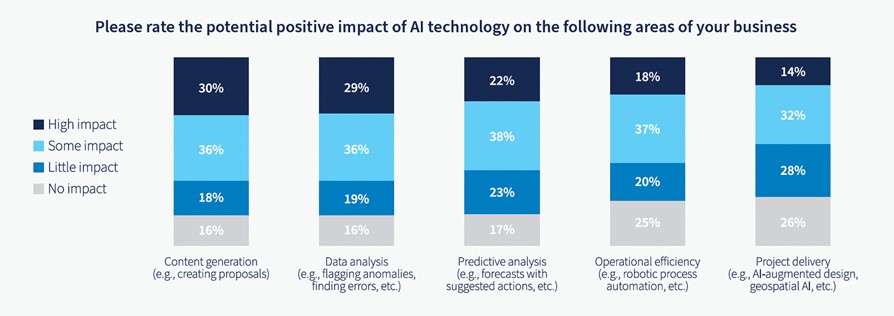
On the business development side, there is a golden opportunity for companies to use AI to elevate their proposal win rate, and thus grow their company. As the 2024 GAUGE report noted, about 60% of companies are winning less than 50% of the proposals they submit. What’s more, almost two-thirds of respondents indicated their win rate didn’t improve year-over-year. By injecting AI into their processes — with analytics to help them evaluate opportunities and decide which to target, and content-generation tools to improve and refine the actual proposals they submit — they can hone in on better opportunities and win more of those they pursue. AI can digest vast amounts of data, uncover lucrative new business opportunities, and zero in on projects and clients that align with a company’s strategic priorities. AI algorithms also can predict the probability of success for projects.
Later, during the proposal-creation process, AI can help a proposal team interpret complex contract language, research contract clauses like FARS, analyze large documents for key insights, and predict optimal pricing strategies. Intelligent templates can minimize manual effort and ensure consistency and accuracy during RFP creation, so you don’t have to reinvent the wheel with every proposal. A company’s proposal-generation capacity and overall proposal quality should improve as a result — without increasing headcount.
In the project management office, AI shows great promise for improving resource management, as well as project execution. It’s a versatile tool that can empower timelier project decision-making and substantially improve efficiency by automating clauses, project codes, task creation, and payment processing. It can improve cost control by alerting decision-makers to cost trends and potential overruns, providing recommendations for how to address them. It can provide insight from timesheet and payroll data for improved resource tracking over the project lifecycle, and generate real-time insight into project progress, delays, milestones, budget variances, and resource utilization. Using AI-driven predictive analytics, companies can optimize the composition of project teams based on an analysis of peoples’ skills, certifications, and performance. AI can also alert a company to potential labor shortages.
The relatively few companies that are using AI within their finance & accounting operation are seeing benefits as a result. In the 2024 GAUGE Report, companies that use AI are much less likely to have invoice cycles longer than 15 days relative to companies that don’t use AI — 8% compared to 18%. Small GovCon companies with cash flow pressures, take note. Intelligent AR (accounts receivable) and AP (accounts payable) automation tools show great promise for taking manual work off peoples’ plates and helping companies get paid more efficiently, securely, and accurately, which benefits cash flow as well as forecasting and planning. In addition, companies that indicated use of AI today are twice as likely to have higher profit margins.
According to the 2024 GAUGE Report, almost 40% of companies are either considering how to use AI or are already using AI to support greater efficiency in compliance. This makes sense in light of the heavy compliance burden companies face from audits, the Federal Acquisition Regulation (FAR), DFARs, CAS and CMMC 2.0. AI models can be trained to interpret the language of the FAR and to flag compliance risks like mismatched data or unallowable costs. AI can also help create policies and procedures GovCons can use to maintain compliance. It can save resource-challenged companies vast amounts of time by analyzing and applying rules by contract or project, by continuously monitoring time and expense entries, and by detecting and alerting companies to data disparities across systems and reports.
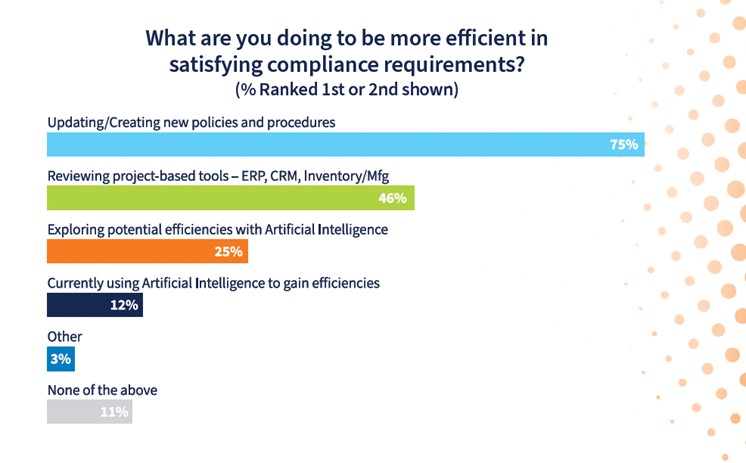
AI can indeed deliver a wide range of benefits to a government contracting company — provided they lay the groundwork for success. Companies that are most successful with AI tend to be those that are methodical in their AI deployment, beginning with identifying the processes and systems where AI can provide the most value. Once they identify use cases, they’re diligent in finding AI tools that are well suited to those use cases. They’re intentional about building internal AI expertise so people understand the AI tools at hand, and why they’re being used, and about putting AI ethics and governance policies and processes in place.
Because the models behind AI depend on data to learn and yield insight, AI-mature companies ensure the data feeding their AI models is fresh, reliable, relevant and secure. They also map AI-based processes and tools to compliance requirements. They start by piloting AI with a proof-of-concept, setting goals and establishing KPIs for how they’ll measure success, with an eye toward scaling successful use cases. They gather feedback about the user experience and measure the effectiveness of AI tools relative to KPIs. And they aren’t afraid to explore new AI capabilities and applications, knowing not all are going to hit the mark.
As the 2024 GAUGE Report noted, “there is no doubt that AI will prove a valuable ally in navigating the pressures facing GovCons today.” The faster a company can mature in its use of AI, the more valuable an ally AI becomes.
Kim Koster is vice president of product marketing at Unanet, a software company that provides enterprise resource planning and customer relationship management solutions for organizations in the government contracting, architecture, engineering, construction and professional services markets. https://unanet.com/

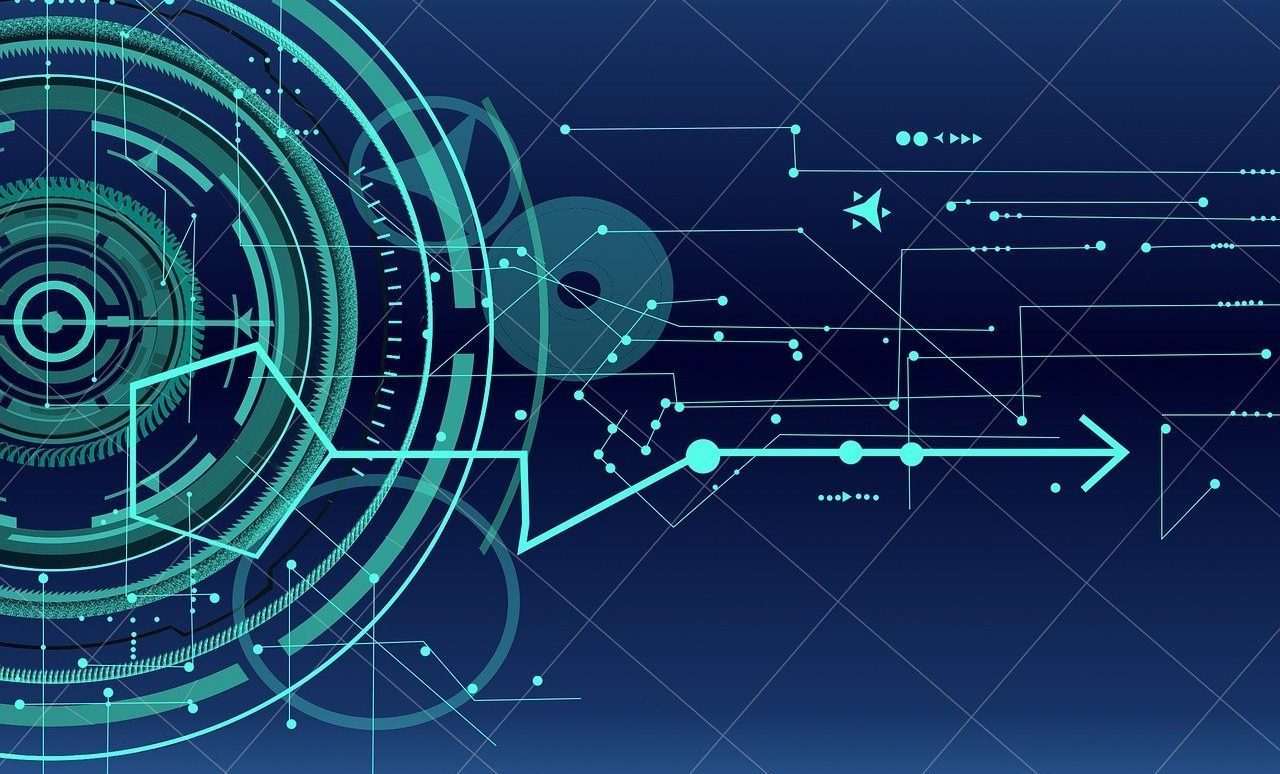
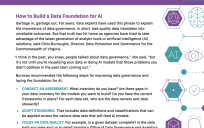


Leave a Reply
You must be logged in to post a comment.